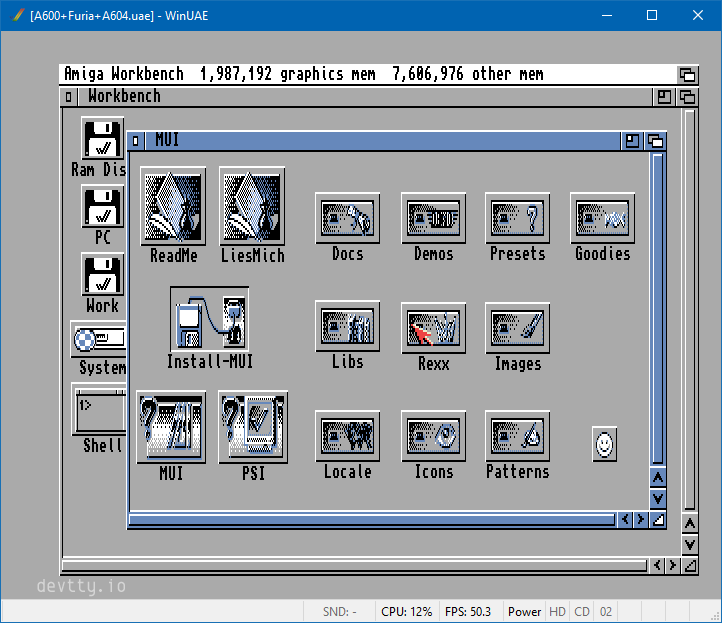
One way of booting harddrives on the Replay is by using hard disk files (HDF’s).
The Amiga 500 (kickstart 1.3) had no native support for harddrives though, so we need to patch it in.
Amigaos 3.1 Adf Download. If I'm wrong, fair do's; Evidious, tell us how it goes. For the workbench images, you can also try: If mrnukem's suggestion doesn't work, you'll need either a drive which can write Amiga disk formats, like a CatWeasel, or an Amiga 1200 - they can read 720kB DOS disks. Copy the.adf image to a 720kB DOS disk, create a. Classic Workbench. Download an Amiga Workbench OS. Preinstalled packs setup for real. A500+ A600 A1200 A1500+ A2000+ A3000 A4000 and UAE. Use the appropriate Kickstart ROM (probably the same as in your amiga). It needs to be version 3.0 or 3.1. Add the Workbench installer disk image to DF0. It should not be write protected (use a copy if you don’t want to risk modifying your original image). Hard drive (Compact Flash, really). WB 3.1 – Workbench.adf, wb31-workbench.adf. WB 3.1 – Locale.adf, wb31-locale.adf. Amiga 1000 Kickstart Disk v1.1 rev 31.34 NTSC.adfDownload Disk. Amiga 1000 Kickstart ROM v1.1 rev 31.34. These two drivers allow an Amiga floppy drive to read and write 720KB or 1.44MB MS-DOS disks, depending on the capacity of your Amiga disk drive.
Amiga Workbench 3.1 Disk Download
We want to add IDE support to the kickstart, and this patch will, don’t let the SCSI part of the name confuse you. I will not go into the details on why it’s called SCSI patch, but this is the one to use. It’s a backward compatibility thing.
This is what you need to get this done.
- An Amiga 68020+ , real or emulated, with Kickstart 3.1 (rev 40.068)
- A Kickstart 1.3 ROM file (rev 34.005)
- The A590 setup drive disk (google it).
Let’s get started
Now copy the following files over to your real or emulated A1200/4000 with kickstart 3.1:
- Your Kickstart 1.3 ROM file (rev 34.005)
- kick34005.A500.gpatch (from Kickstart 1.3 SCSI patch)
- scsi.device_40.12 (A1200) _rom.gpatch (from Kickstart 1.3 SCSI patch)
- gpatch (from GPatch)
- GetSCSI (from GetSCSI)
- Workbench 1.3 and Extras 1.3 ADF files
Open a Shell/CLI and CD into the directory where you put the files and type the following:
- 1> getcsi
- 1> gpatch kick34005.A500 kick34005.A500.gpatch kick34005.A500_patched
- 1> gpatch scsi.device scsi.device_40.12 (A1200) _rom.gpatch scsi_patched.rom
- 1> join scsi_patched.rom kick34005.A500_patched TO kick13ide.rom
This will give you a new patched kickstart file called kick13ide.rom that will be able to boot from a hard disk file (HDF).
Creating a HDF file with FS-UAE
I tried this with WinUAE, but couldn’t get it to work, so use FS-UAE and create a new hard disk file (HDF) by clicking:
And then:
Amiga Workbench 3.1 Hdf For Sale
Don’t make the HDF bigger than 1 GB and make sure you create a partitionable disk as shown here:
Write (PrepHD) of the Fast File System handler
At this point we can use our Replay to fine tune the rest. Add the newly created kick13ide.rom to your Amiga 500 ini file like this:
ROM =kick13ide.rom,0x80000,0x00F80000
Amiga Workbench 3.1 Hdf System
Select your newly created empty HDF as master drive in the OSD of the Replay and insert the A590 setup disk into DF0 using the OSD menu and now do a “Reset target”.
Now, open a shell window and type the following command:
Press Y to continue and reboot the Amiga core when it’s done. After rebooting, open the shell again and format the hard disk file (HDF) by typing the following in a shell window:
Our hard disk file (HDF) is now done! To install the workbench to the hard disk file (HDF), launch InstallHD from the The A590 setup disk. Insert the Workbench 1.3 and Extras 1.3 ADF disks files when asked to and all files will be copied over to our hard disk file and it will be made bootable.
Eject the The A590 setup disk and reboot, your Replay should now boot into a fresh Workbench 1.3 environment directly from your hard disk file! Have fun!
A lot of the info in this article was found here, thanks to Francesco Sblendorio from Retroacademy for the info.